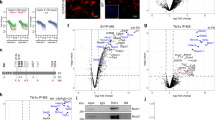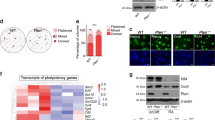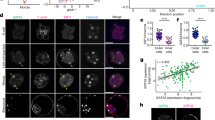Abstract
In blastocyst chimeras, embryonic stem (ES) cells contribute to embryonic tissues but not extraembryonic trophectoderm. Conditional activation of HRas1Q61L in ES cells in vitro induces the trophectoderm marker Cdx2 and enables derivation of trophoblast stem (TS) cell lines that, when injected into blastocysts, chimerize placental tissues. Erk2, the downstream effector of Ras–mitogen-activated protein kinase (MAPK) signaling, is asymmetrically expressed in the apical membranes of the 8-cell-stage embryo just before morula compaction. Inhibition of MAPK signaling in cultured mouse embryos compromises Cdx2 expression, delays blastocyst development and reduces trophectoderm outgrowth from embryo explants. These data show that ectopic Ras activation can divert ES cells toward extraembryonic trophoblastic fates and implicate Ras-MAPK signaling in promoting trophectoderm formation from mouse embryos.
This is a preview of subscription content, access via your institution
Access options
Subscribe to this journal
Receive 12 print issues and online access
$209.00 per year
only $17.42 per issue
Buy this article
- Purchase on Springer Link
- Instant access to full article PDF
Prices may be subject to local taxes which are calculated during checkout




Similar content being viewed by others
References
Nagy, A. et al. Embryonic stem cells alone are able to support fetal development in the mouse. Development 110, 815–821 (1990).
Tanaka, S., Kunath, T., Hadjantonakis, A.K., Nagy, A. & Rossant, J. Promotion of trophoblast stem cell proliferation by FGF4. Science 282, 2072–2075 (1998).
Kunath, T. et al. Imprinted X-inactivation in extra-embryonic endoderm cell lines from mouse blastocysts. Development 132, 1649–1661 (2005).
Land, H., Parada, L.F. & Weinberg, R.A. Tumorigenic conversion of primary embryo fibroblasts requires at least two cooperating oncogenes. Nature 304, 596–602 (1983).
Hahn, W.C. et al. Creation of human tumour cells with defined genetic elements. Nature 400, 464–468 (1999).
Kyba, M., Perlingeiro, R.C. & Daley, G.Q. HoxB4 confers definitive lymphoid-myeloid engraftment potential on embryonic stem cell and yolk sac hematopoietic progenitors. Cell 109, 29–37 (2002).
Klucher, K.M., Lopez, D.V. & Daley, G.Q. Secondary mutation maintains the transformed state in BaF3 cells with inducible BCR/ABL expression. Blood 91, 3927–3934 (1998).
Simmons, D.G. & Cross, J.C. Determinants of trophoblast lineage and cell subtype specification in the mouse placenta. Dev. Biol. 284, 12–24 (2005).
Katsuki, M. et al. Embryonal tumors from transgenic mouse zygotes carrying human activated c-Ha-ras genes. Mol. Biol. Med. 6, 567–572 (1989).
Zaehres, H. et al. High-efficiency RNA interference in human embryonic stem cells. Stem Cells 23, 299–305 (2005).
Nichols, J. et al. Formation of pluripotent stem cells in the mammalian embryo depends on the POU transcription factor Oct4. Cell 95, 379–391 (1998).
Strumpf, D. et al. Cdx2 is required for correct cell fate specification and differentiation of trophectoderm in the mouse blastocyst. Development 132, 2093–2102 (2005).
Mitsui, K. et al. The homeoprotein Nanog is required for maintenance of pluripotency in mouse epiblast and ES cells. Cell 113, 631–642 (2003).
Niwa, H. et al. Interaction between Oct3/4 and Cdx2 determines trophectoderm differentiation. Cell 123, 917–929 (2005).
Takahashi, K., Mitsui, K. & Yamanaka, S. Role of ERas in promoting tumour-like properties in mouse embryonic stem cells. Nature 423, 541–545 (2003).
Burdon, T., Chambers, I., Stracey, C., Niwa, H. & Smith, A. Signaling mechanisms regulating self-renewal and differentiation of pluripotent embryonic stem cells. Cells Tissues Organs 165, 131–143 (1999).
Hamatani, T., Carter, M.G., Sharov, A.A. & Ko, M.S. Dynamics of global gene expression changes during mouse preimplantation development. Dev. Cell 6, 117–131 (2004).
Maekawa, M. et al. Requirement of the MAP kinase signaling pathways for mouse preimplantation development. Development 132, 1773–1783 (2005).
Maekawa, M., Yamamoto, T., Kohno, M., Takeichi, M. & Nishida, E. Requirement for ERK MAP kinase in mouse preimplantation development. Development 134, 2751–2759 (2007).
Cheng, A.M. et al. Mammalian Grb2 regulates multiple steps in embryonic development and malignant transformation. Cell 95, 793–803 (1998).
Chazaud, C., Yamanaka, Y., Pawson, T. & Rossant, J. Early lineage segregation between epiblast and primitive endoderm in mouse blastocysts through the Grb2-MAPK pathway. Dev. Cell 10, 615–624 (2006).
Auman, H.J. et al. Transcription factor AP-2γ is essential in the extra-embryonic lineages for early postimplantation development. Development 129, 2733–2747 (2002).
Saba-El-Leil, M.K. et al. An essential function of the mitogen-activated protein kinase Erk2 in mouse trophoblast development. EMBO Rep. 4, 964–968 (2003).
Yagi, R. et al. Transcription factor TEAD4 specifies the trophectoderm lineage at the beginning of mammalian development. Development 134, 3827–3836 (2007).
Piotrowska-Nitsche, K., Perea-Gomez, A., Haraguchi, S. & Zernicka-Goetz, M. Four-cell stage mouse blastomeres have different developmental properties. Development 132, 479–490 (2005).
Johnson, M.H. & Ziomek, C.A. Induction of polarity in mouse 8-cell blastomeres: specificity, geometry, and stability. J. Cell Biol. 91, 303–308 (1981).
Sutherland, A.E., Speed, T.P. & Calarco, P.G. Inner cell allocation in the mouse morula: the role of oriented division during fourth cleavage. Dev. Biol. 137, 13–25 (1990).
Rajalingam, K. et al. Prohibitin is required for Ras-induced Raf-MEK-ERK activation and epithelial cell migration. Nat. Cell Biol. 7, 837–843 (2005).
De Vries, W.N. et al. Maternal β-catenin and E-cadherin in mouse development. Development 131, 4435–4445 (2004).
Plusa, B. et al. Downregulation of Par3 and aPKC function directs cells towards the ICM in the preimplantation mouse embryo. J. Cell Sci. 118, 505–515 (2005).
Acknowledgements
This study was supported by grants from the US National Institutes of Health and the NIH Director's Pioneer Award of the NIH Roadmap for Medical Research. G.Q.D. is a recipient of the Burroughs Wellcome Fund Clinical Scientist Award in Translational Research. We are grateful to J. Rossant (Hospital for Sick Children, University of Toronto, Canada) for providing TS cells and experimental advice and for critical reading of this manuscript.
Author information
Authors and Affiliations
Contributions
C.-W.L. designed and executed experiments and wrote the manuscript. A.Y., L.C., S.V. and K.K. executed experiments, contributed reagents, and edited the manuscript. G.Q.D. designed the experiments and wrote the manuscript.
Corresponding author
Supplementary information
Supplementary Text and Figures
Supplementary Tables 1 and 2, Supplementary Figures 1–4 and Supplementary Note (PDF 709 kb)
Rights and permissions
About this article
Cite this article
Lu, CW., Yabuuchi, A., Chen, L. et al. Ras-MAPK signaling promotes trophectoderm formation from embryonic stem cells and mouse embryos. Nat Genet 40, 921–926 (2008). https://doi.org/10.1038/ng.173
Received:
Accepted:
Published:
Issue Date:
DOI: https://doi.org/10.1038/ng.173
This article is cited by
-
Identification of miR-192 target genes in porcine endometrial epithelial cells based on miRNA pull-down
Molecular Biology Reports (2023)
-
Effect of vitrification on biogenesis pathway and expression of development-related microRNAs in preimplantation mouse embryos
Cell and Tissue Banking (2021)
-
Phosphoproteomics identifies a bimodal EPHA2 receptor switch that promotes embryonic stem cell differentiation
Nature Communications (2020)
-
Etv5 safeguards trophoblast stem cells differentiation from mouse EPSCs by regulating fibroblast growth factor receptor 2
Molecular Biology Reports (2020)
-
Optogenetic stimulation inhibits the self-renewal of mouse embryonic stem cells
Cell & Bioscience (2019)



